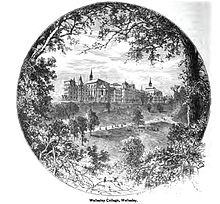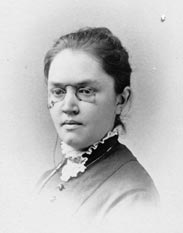Katharine Coman
Katharine Coman | |
|---|---|
 | |
| Born | November 23, 1857 Newark, Ohio, U.S. |
| Died | January 11, 1915 (aged 57) Wellesley, Massachusetts, U.S. |
| Occupation | Professor |
| Alma mater | University of Michigan |
| Partner | Katharine Lee Bates |
Katharine Ellis Coman (November 23, 1857 – January 11, 1915) was an American social activist and professor. She was based at the women-only Wellesley College, Massachusetts, where she created new courses in political economy, in line with her personal belief in social change. As dean, she established a new department of economics and sociology.
Among other admired works, Coman wrote The Industrial History of the United States and Economic Beginnings of the Far West: How We Won the Land Beyond the Mississippi. She was the first female statistics professor in the US, the only woman co-founder of the
Early life
Coman was born in 1857 to Martha Ann Seymour Coman (1826–1911) and Levi Parsons Coman (1826–1889) in
Wellesley College

After earning her PhB, she joined the faculty at Wellesley College, a newly established private college for women in Wellesley, Massachusetts. Angell recommended her for the position, noting her talent for teaching.[4] She first taught English rhetoric,[1] and in 1881 became an instructor in history.[6] In 1883, she was promoted to full professor of history.[1][4] Because Coman believed that economics could address social problems, she urged the Wellesley administration to offer courses on the subject, and in 1883, she taught the college's first political economy class.[4] Coman was the first American woman to teach statistics and Wellesley became the only American women's college to offer statistics courses before 1900.[4][7]
Coman developed and taught several new courses in economics, history, and rhetoric, including Statistical Study of Economic Problems, Industrial History of the United States, and Conservation of Our Natural Resources, all framed by sociological insights related to
According to historian Melinda Ponder, Coman was a popular teacher.[9]: 66 Two of her students, Helen Frances Page Bates and Helen Laura Sumner Woodbury, were among the first American women to earn PhDs in economics.[4]: 994 Woodbury is recognized as an important historian of labor and a noted economist,[10] while Helen Bates became a noted social worker.[4]
She retired from full-time teaching at Wellesley in 1913,
Coman's papers are held by the Wellesley College Archives.[13] In 1921, the college established the Katharine Coman Professorship of Industrial History to honor her service.[1][4]: 1001
Notable works
Coman and Elizabeth Kendall coauthored the 1902 book A Short History of England for School Use based on research that Coman conducted in England between 1886 and 1894. Coman published The Industrial History of the United States in 1910, the first industrial history of the United States.
Her 1912 work Economic Beginnings of the Far West: How We Won the Land Beyond the Mississippi was considered by contemporaneous scholars to be her
In this work, Coman describes the historical economic processes that led to the Far West coming under the control of
Settlement movement activist Jane Addams, a close friend, urged Coman to research social insurance programs in Europe in order to establish similar programs in the United States.[3] Coman studied social insurance in England, Spain, Denmark, and Sweden, but poor health prevented her from continuing her research.[3] Her manuscript, "Unemployment Insurance: A Summary of European Systems" was published after her death in 1915.[3][c]
Social activism
Coman was passionate about social and economic issues,
Personal life

For 25 years, Coman lived in a "
Breast cancer and death
Coman first discovered a lump in her left breast in the fall of 1911 and underwent two surgeries in the following months. At the time, medical doctors did not understand the nature of breast cancer, its causes or its treatments, so the prognosis for Coman was poor.[21] Coman died at home in January 1915 at the age of 58.[1][21]: 62 At the time of her death, Coman had been working on an industrial history of New England.[4]: 1001 [22]
During Coman's illness, friends of her and Bates — many of them also in "Wellesley marriages" — took Coman out for walks and visits, and invited her to stay at their country homes. They prepared meals for Coman and Bates, brought flowers and fresh vegetables, and performed tasks and services to keep Coman's spirits up. Bates chronicled Coman's illness in her diary, noting hospital visits, surgical procedures, and details about Coman's pain and suffering.
Assessment
A review of Coman's book Economic Beginnings of the Far West: How We Won the Land Beyond the Mississippi (1912) in the San Francisco Chronicle stated that "the author is one of those new women who have shown what may be accomplished in the way of research by method and industry and a great deal of enthusiasm."[25] In a 1913 review of her book, economist Thomas Nixon Carver praised Coman's narrative style and lively prose.[15] Also writing in 1913, economist Frederic Paxson criticized the book, arguing that there were factual errors and inaccurate citations, and that the data for the book were already widely available in university research libraries. Paxson does credit Coman with having prepared an extensive bibliography and for providing extensive notes.[26] The two-volume book is today hailed as a classic and was reprinted twice; Macmillan in 1925, and Kelly in 1969.[4] The University of Michigan "Naming Project" notes that she was one of the first historians to use local newspaper articles and government documents as primary sources in her teaching and writing.[1]
Gerald F. Vaughn, a contemporary economist writing in 2004, proposes that Coman was America's first female institutional economist. Vaughn notes other important facts about Coman that frame her as a pioneer for women academics, including the fact that at the time, the discipline and profession of economics was dominated by men.[4]: 989 She was the only woman among the group of economists who founded the American Economic Association in 1885 and she was the first American woman to become a statistics professor.[4][7] Vaughn notes that her contributions to economics and social history went beyond being the "first woman," for example writing the first article to be published in The American Economic Review and authoring the first industrial history of the US.[4]: 989 Coman's extensive work on the processes of institutional change in the American West made her an influential industrial historian and The Industrial History of the United States was widely used as a textbook for decades.[4]
In 2011, The American Economic Review commemorated its first hundred years by publishing a list of the top twenty articles in the journal's history. Coman's 1911 article "Some Unsettled Problems of Irrigation," published in 1911, was the first article published by the journal and was reprinted in the 2011 issue.
Selected publications
Books
- Coman, Katharine; Kendall, Elizabeth Kimball (1894). The Growth of the English Nation. Meadville, Pennsylvania: Flood and Vincent.
- Coman, Katharine; Kendall, Elizabeth Kimball (1899). A History of England for High Schools and Academies. London: The Macmillan Company.
- Bates, Katharine Lee; Coman, Katharine, eds. (1902). English History Told by English Poets: A Reader for School Use. New York: The Macmillan Company. ISBN 0-8369-6097-1. (reprinted 1908, 1911, 1914)
- Coman, Katharine (1905). The Industrial History of the United States. New York: The Macmillan Company. (reprinted in 1906, 1907, 1908; revised 1910; reprinted 1912, 1918, 1973)
- Coman, Katharine (1912). Economic Beginnings of the Far West: How We Won the Land Beyond the Mississippi. New York: The Macmillan Company. (reprinted 1925; 1969)
Articles
- Coman, Katharine (1891). "The Tailoring Trade and the Sweating System". Publications of the American Economic Association. 6 (1/2): 144–147. JSTOR 2560467.
- Coman, Katharine (1893). "Wages and Prices in England, 1261–1701". Journal of Political Economy. 2 (1): 92–94. S2CID 153414904.
- Coman, Katharine (1903). "The History of Contract Labor in the Hawaiian Islands". Publications of the American Economic Association. 4 (3): 1–61. JSTOR 2485748.
- Coman, Katharine (1904). "The Negro as a Peasant Farmer". Publications of the American Statistical Association. 9 (66): 39–54. S2CID 152426897.
- Coman, Katharine; Bogart, Ernest L.; Ely, Richard T.; Gay, Edwin F. (1907). "Stages of Economic Development.-Discussion". Publications of the American Economic Association. 8 (1): 127–136. JSTOR 2999900.
- Coman, Katharine. (1911). "Some Unsettled Problems of Irrigation." The American Economic Review 1(1): 1–19. Reprinted in 2011 as The American Economic Review 101: 36–48.
References
- Notes
- ^ According to Katharine Lee Bates, the book "best expresses [Coman's] vigorous and adventurous personality.[6]: xi
- American Southwest, the Mormon migration to Utah, early explorers of the West, and the creation of the states of Kansas and Oregon.[15]
- ^ Coman's notes from the study of old age pensions and unemployment social insurance in Europe are housed at Wellesley in the Katharine Coman Papers Collection.[13]
- ^ Writing in 1952, Burgess wrote that Coman was Bates' "dearest companion of her life."[5]: 209
- ^ In the poem, "In Cedar Hill Cemetery (Newark, Ohio)," Bates writes:
O ashes, memory of moral love,
Sealed in your urn beneath the greensward, pure
From evil, what am I to weep above
Your beautiful and tranquil sepulture?[6]: 41
- Citations
- ^ a b c d e f g h "Katharine Coman". sites.lsa.umich.edu. Archived from the original on March 10, 2019. Retrieved July 7, 2018.
- ^ a b c d e f Norley, Katharine. (2006). "Coman, Katharine (1857–1915)," p. 166 in The biographical dictionary of American economists, Volume I, A–I, edited by Ross B. Emmett. Thoemmes Continuum: London.
- ^ ISBN 9780313296642.
- ^ S2CID 157322660.
- ^ a b c d e f Burgess, Dorothy. (1952). Dream and Deed: The Story of Katharine Lee Bates. Norman: University of Oklahoma Press.
- ^ a b c d Bates, Katharine Lee. (1922). Yellow Clover: A Book of Remembrance. New York: E. P. Dutton & Company.
- ^ JSTOR 2685503.
- ^ "Learning to be statesmen". The Newark Daily Advocate. October 5, 1893. p. 3. Retrieved September 2, 2018.
- ^ ISBN 9781941478486
- ^ "Helen Laura Sumner Woodbury | American economist". Encyclopedia Britannica. Retrieved July 6, 2018.
- ^ a b "Farewell dinner to Miss Coman". The New York Times. May 4, 1913. p. 11. Retrieved September 2, 2018.
- ^ "New Wellesley dean". The New York Times. March 30, 1913. p. 8. Retrieved September 2, 2018.
- ^ a b "Katharine Coman papers" (PDF). Wellesley College Archives. August 31, 2017. Retrieved July 5, 2018.
- ^ "Two notable books published recently by members of faculty". The New York Times. November 17, 1912. p. 15. Retrieved September 2, 2018.
- ^ JSTOR 1827962.
- ^ "The 1910 Chicago Garment Workers' Strike, Document List". womhist.alexanderstreet.com. Retrieved July 6, 2018.
- ^ Sawyers, June (June 12, 1988). "The Strike That Shook Up An Entire Industry". Chicago Tribuneaccess-date=9 September 2018.
- ^ ISBN 0547348401
- ISBN 9780226923802
- ^ PMID 11616990.
- ^ S2CID 162810249.
- ^ "Obituary". The New York Times. January 12, 1915. p. 9. Retrieved September 2, 2018.
- ^ S2CID 162263019.
- ^ Watson, Catherine (December 15, 2002). "Life of song's author reveals a profile in literary courage". Star Tribune. pp. G7–8. Retrieved September 2, 2018.
- ^ "Beginnings of Far West: An Elaborate Work in Two Volumes by Katharine Coman". San Francisco Chronicle. November 10, 1912. p. 48. Retrieved September 2, 2018.
- ISSN 0002-8762.
- ^ .
- hdl:1721.1/114169.
- .
External links
- A private life (note photo) at the Wayback Machine (archived 17 December 2002)
- Works by or about Katharine Coman at Internet Archive


